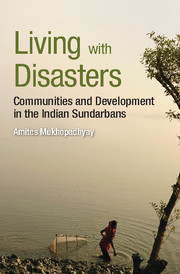Book contents
- Frontmatter
- Dedication
- Contents
- Maps and Illustrations
- Tables and Charts
- Glossary
- Acronyms
- Acknowledgements
- Note on Transliteration
- Maps
- Illustrations
- Charts
- 1 Introduction
- 2 From Wasteland to Wonderland: The Making of a Heritage Site
- 3 Governing the Sundarbans Embankments Today: Between Policies and Practices
- 4 Treading a Fine Path between River and Land: Livelihoods around Embankment
- 5 Beldars, Embankment and Governance: Question of Aboriginality Revisited
- 6 Catching Prawn, Endangering Embankments: Sustainability-Unsustainability Rhetoric
- 7 Conclusion
- Bibliography
- Index
7 - Conclusion
Published online by Cambridge University Press: 05 March 2016
- Frontmatter
- Dedication
- Contents
- Maps and Illustrations
- Tables and Charts
- Glossary
- Acronyms
- Acknowledgements
- Note on Transliteration
- Maps
- Illustrations
- Charts
- 1 Introduction
- 2 From Wasteland to Wonderland: The Making of a Heritage Site
- 3 Governing the Sundarbans Embankments Today: Between Policies and Practices
- 4 Treading a Fine Path between River and Land: Livelihoods around Embankment
- 5 Beldars, Embankment and Governance: Question of Aboriginality Revisited
- 6 Catching Prawn, Endangering Embankments: Sustainability-Unsustainability Rhetoric
- 7 Conclusion
- Bibliography
- Index
Summary
Eroding embankments, state machinery and vulnerable lives
The Sundarbans islanders do not have proper roads, bridges across the rivers or electricity in the villages. In these respects, they remain as deprived as those living in forests elsewhere. The Sundarbans delta is pregnant with possibilities. Therefore, to assign primacy to the needs of people, fresh developmental thinking needs to be generated in the region. However, thinking needs to be translated fast into practice, for otherwise, one will not be surprised if tidal waves with their surging water level destroy weak embankments inundating all the fifty-four inhabited islands[in the Indian Sundarbans] … One has to pay huge cost, if the Sundarbans – a rich resource site, a unique confluence of water, forests and settlements, one of the largest mangrove regions, an elixir to the tired nerves of Kolkata, West Bengal and perhaps India – continues to remain neglected. To ensure that the Sundarbans survives, there need to be concerted efforts on the part of the panchayats, voluntary agencies, administration of the two districts, the state and central governments towards building and conserving the Sundarbans embankments. If the embankments are built and properly taken care of, all other developments in the region will be sustainable. But if the embankments are neglected and a priority is given to piece-meal development, the Sundarbans will eventually relapse into uninhabited jungles. Protecting the embankments not only means preserving the lives of 43 lakhs [4.3 million] people of the Sundarbans, but also means achieving a delicate balance between people living in the Sundarbans and those living outside (Nayek 2005, 2; translated from vernacular).
The embankments are found still lying breached even five years after the cyclone Aila. People's vulnerability to disaster continues unabated (Oliver-Smith 1996, 315) as land continues to erode and people are found to be on the retreat. Hence the question remains is where will all this backtracking lead? In this book, our journey had started with the eroding lives of north Kusumpur where subsequently the cyclone Aila had caused many to leave their home. For those still living in this narrow stretch, the land had become even narrower. As has been discussed in the earlier chapters of the book, people keep negotiating their time with the rivers and with the government machinery meant for flood control.
- Type
- Chapter
- Information
- Living with DisastersCommunities and Development in the Indian Sundarbans, pp. 146 - 156Publisher: Cambridge University PressPrint publication year: 2016



